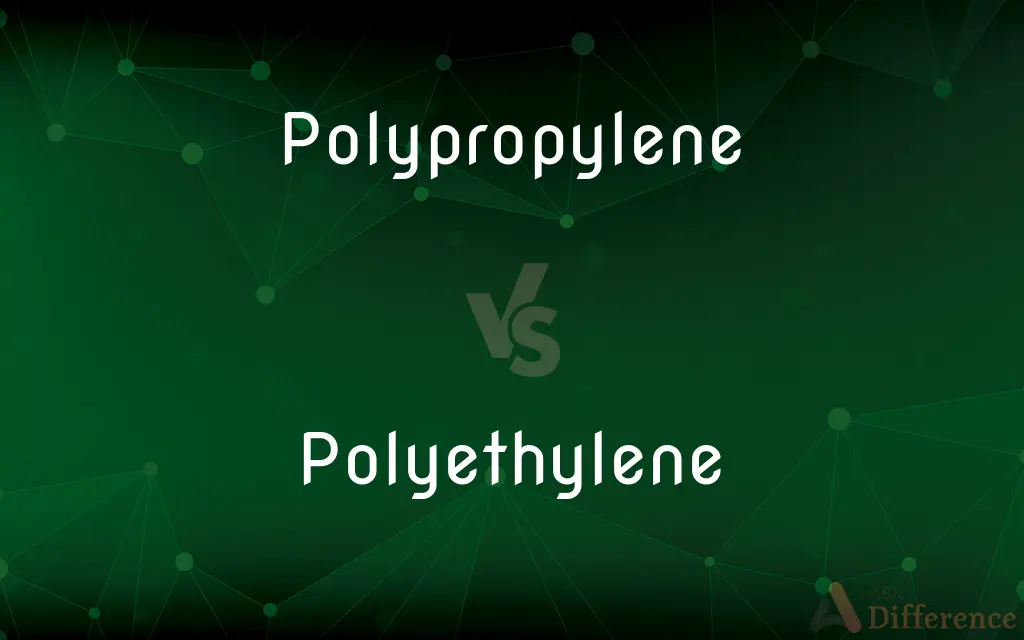Polypropylene vs. Polyethylene — What's the Difference?
Edited by Tayyaba Rehman — By Fiza Rafique — Updated on November 2, 2023
Polypropylene (PP) is tough, resistant to chemicals, and used in plastics; polyethylene (PE) is more flexible, used in packaging, films, and containers.

Difference Between Polypropylene and Polyethylene
Table of Contents
ADVERTISEMENT
Key Differences
Polypropylene is a polymer known for its stiffness and resistance to chemical solvents, bases, and acids. It is often used in products that require a higher working temperature and more rigidity, like automotive parts, industrial fibers, and household goods. Polyethylene, on the other hand, is renowned for its flexibility and is the most common plastic globally, used in packaging films, bottles, and plastic bags.
Polypropylene has a higher melting point than polyethylene, which typically stands around 130°C to 171°C, making it suitable for applications that could involve high temperatures. Polyethylene has a lower melting point, around 115°C for LDPE, which can be an advantage for heat sealing processes in packaging but limits its use in high-temperature environments.
The fatigue resistance of polypropylene is one of its key characteristics; it can be flexed repeatedly without stress cracking. This makes it ideal for use in hinges or parts that need to be durable and withstand repeated use. Polyethylene, while still tough, is more susceptible to stress cracking under repeated flexing, making it less ideal for such applications.
Polypropylene is less dense than polyethylene, contributing to its lighter weight in final products. This can be particularly advantageous in applications where weight saving is crucial, such as in automotive or aviation parts. Polyethylene is denser, which can make products made from it heavier, but it also has excellent impact resistance, making it suitable for containers and packaging that need to withstand drops or blows.
In environmental terms, both polypropylene and polyethylene are recyclable. However, polypropylene is less commonly recycled due to fewer facilities and a lower recovery rate, while polyethylene, especially HDPE and LDPE, has a higher recycling rate due to its widespread use in containers and packaging.
ADVERTISEMENT
Comparison Chart
Melting Point
Higher (130°C to 171°C)
Lower (around 115°C for LDPE)
Flexibility
Less flexible, more rigid
More flexible
Chemical Resistance
High resistance
Good resistance, varies with type
Fatigue Resistance
Excellent, resists stress cracking
Less, prone to stress cracking
Common Uses
Auto parts, industrial fibers
Packaging films, containers
Density
Lower density
Higher density
Recyclability
Less commonly recycled
More commonly recycled
Compare with Definitions
Polypropylene
Polypropylene is a rigid and chemical-resistant plastic.
The laboratory containers are made of polypropylene to withstand strong chemicals.
Polyethylene
It’s widely used in films, packaging, and containers due to its durability.
Polyethylene film is used to securely wrap pallets of goods for shipping.
Polypropylene
It is used for plastic parts, containers, and textiles due to its toughness.
Polypropylene is preferred for making durable outdoor rugs.
Polyethylene
This thermoplastic is popular for its ease of processing and low cost.
Manufacturers often choose polyethylene for household goods to keep costs down.
Polypropylene
Polypropylene has a high melting point, suitable for autoclaving.
Medical equipment made from polypropylene can be sterilized at high temperatures.
Polyethylene
Polyethylene has excellent impact resistance and is used in bulletproof vests.
The police vests are reinforced with layers of ultra-high molecular weight polyethylene.
Polypropylene
This thermoplastic polymer is recognized for being lightweight and recyclable.
The eco-friendly packaging was crafted from recycled polypropylene.
Polyethylene
Polyethylene is a common flexible and lightweight plastic.
The grocery bags are made from high-density polyethylene for extra strength.
Polypropylene
Polypropylene is commonly used in packaging, labeling, and reusable products.
The reusable water bottle is made from food-grade polypropylene.
Polyethylene
Polyethylene is recyclable and found in various densities for different applications.
Low-density polyethylene is preferred for its flexibility in making squeeze bottles.
Polypropylene
Polypropylene (PP), also known as polypropene, is a thermoplastic polymer used in a wide variety of applications. It is produced via chain-growth polymerization from the monomer propylene.
Polyethylene
Polyethylene or polythene (abbreviated PE; IUPAC name polyethene or poly(methylene)) is the most common plastic in use today. It is a polymer, primarily used for packaging (plastic bags, plastic films, geomembranes and containers including bottles, etc.).
Polypropylene
A synthetic resin which is a polymer of propylene, used chiefly for films, fibres, or moulding materials
High-impact polypropylene
Polypropylene underwear
Polyethylene
A polymerized thermoplastic ethylene resin, used especially for containers, kitchenware, and tubing, or in the form of films and sheets for packaging.
Polypropylene
Any of various thermoplastic polymers of propylene. They are hard and tough, and are used to make molded articles and fibers.
Polyethylene
(organic compound) A polymer consisting of many ethylene monomers bonded together; used for kitchenware, containers etc.
Polypropylene
A fabric of fibers made from any of these polymers.
Polyethylene
A lightweight thermoplastic; used especially in packaging and insulation
Polypropylene
A thermoplastic resin made by the polymerization of propylene, and used for films, fibres, or moulding materials. Also known as polypropene.
Polypropylene
A polymer of propylene used as a thermoplastic molding material
Common Curiosities
What distinguishes polyethylene in its applications?
Its flexibility makes polyethylene ideal for packaging and containers.
Is polyethylene safe for food contact?
Yes, food-grade polyethylene is safe for food contact.
Which is more chemically resistant, polypropylene or polyethylene?
Polypropylene generally has higher chemical resistance.
Can polypropylene be clear or is it always opaque?
It can be made to be translucent but is not as clear as some types of polyethylene.
What is polypropylene commonly used for?
Polypropylene is used for products requiring rigidity and heat resistance, like automotive parts.
Can polypropylene withstand boiling water?
Yes, its high melting point allows it to withstand boiling water without deforming.
Are polypropylene and polyethylene resistant to UV light?
Both plastics can be UV-stabilized but generally polyethylene is more resistant.
Are both polypropylene and polyethylene recyclable?
Yes, both are recyclable but recycling facilities may vary.
What types of polyethylene are there?
The most common are LDPE (Low-Density Polyethylene) and HDPE (High-Density Polyethylene).
Do polypropylene and polyethylene have different densities?
Yes, polypropylene is less dense compared to polyethylene.
Can polypropylene be used for textiles?
Yes, it is often used in ropes, carpets, and thermal underwear.
Is polyethylene suitable for outdoor applications?
Yes, especially HDPE, due to its durability and resistance to moisture.
What is the environmental impact of polypropylene and polyethylene?
Both are long-lasting plastics that can contribute to pollution if not properly recycled.
Is polyethylene used in piping?
Yes, especially HDPE pipes for water and gas distribution.
How do polypropylene and polyethylene react to fire?
Both can burn, but polypropylene is slightly more flammable.
Share Your Discovery

Previous Comparison
Theory vs. Philosophy
Next Comparison
Commendation vs. RecommendationAuthor Spotlight
Written by
Fiza RafiqueFiza Rafique is a skilled content writer at AskDifference.com, where she meticulously refines and enhances written pieces. Drawing from her vast editorial expertise, Fiza ensures clarity, accuracy, and precision in every article. Passionate about language, she continually seeks to elevate the quality of content for readers worldwide.
Edited by
Tayyaba RehmanTayyaba Rehman is a distinguished writer, currently serving as a primary contributor to askdifference.com. As a researcher in semantics and etymology, Tayyaba's passion for the complexity of languages and their distinctions has found a perfect home on the platform. Tayyaba delves into the intricacies of language, distinguishing between commonly confused words and phrases, thereby providing clarity for readers worldwide.














































